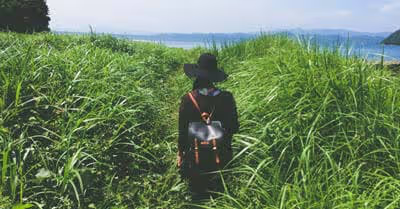Table of Contents
Analog VS Digital Compasses
Analog compasses have the advantage of not requiring any power source.
The analog compass is a wonderfully simple invention. The natural magnetism of the needle and the earth makes the compass needle point north. Another advantage of an analog compass is that you do not need to calibrate it.
A digital compass requires battery power, making it in one way less reliable than an analog compass. However, a digital compass is accurate in many situations where an analog compass is not. If there are magnetic ore deposits in the ground locally, an analog compass will give you the wrong reading; a digital compass does not have this problem.
A digital compass uses a different technology. Instead of a simple magnet, a digital compass uses an electronic sensor that calculates directions from the earth's magnetic field.
Do you need a compass that you can use in the dark?
Some compasses light up at night. With a digital compass, the lighting is battery powered. Analog compasses may use glow in the dark paint, which works well enough to make them readable.
Not all compasses work everywhere
A compass that works well in one part of the world may not balance properly in a different location. Many compasses are made for only one of the world's five compass zones, divided up by latitude.
With an ordinary analog compass, you will not get an accurate reading outside of the zone your compass is designed for. The earth's magnetic field is different at different latitudes, so the needle will not balance properly on a different continent.
However, some analog compasses use a global needle. A global needle can work while the compass is tilted, so it will work in any of the world's five zones.
Another advantage is that you do not have to hold a compass with a global needle very flat while you read it. You may be able to read a compass while you walk if it has a global needle.
Don't store your compass near anything magnetic
If you store a compass near a magnetic field or electrical field, you may ruin it. The needle may lose its magnetism and become useless. Don't store your compass right up against your phone or any other electronic device.
True north is not the same as magnetic north
On a globe, true north is the "top" of the world. It is where the latitude and longitude lines meet. It is defined based on the shape of the world and not where a compass points.
A compass does not point to the top of the globe. Instead, it points to a slightly different location, which is where the earth's magnetic field pulls it.
If you want to know how to navigate with an analog compass properly, you should know how to calculate true north.
Depending on where you are in the world, true north is a certain number of degrees either east of or west of magnetic north. Some compasses have adjustable declination, which makes true north easy to calculate. You can look up how many degrees you must adjust for in your location.
Is it possible to tell which direction north is without using a compass?
Yes, but it is hard to do this accurately. The most obvious way is to go by the movement of the sun. The sun's path is roughly the east-west line, and if you know where east and west are, you can roughly find north and south.
However, this is not accurate - you will only get very rough directions in this way. If you know how to navigate by the stars, you can find directions by looking at the night sky. Going by the stars is a bit better, but a compass is always easier to navigate with and more accurate.
The best compasses a hiker can buy in 2020
1) Sunnoto MC-2G Global
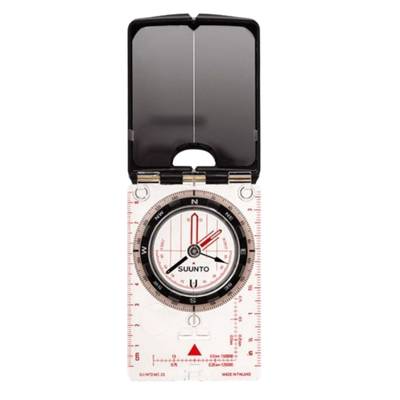
Sunnoto MC-2G Global
Sunnoto is one of the biggest names in compasses, so you can count on their products to work reliably and be worth their price. Sunnoto makes digital and analog compasses of all kinds and is always releasing new products.
If you are looking for an analog compass that works anywhere, the MC-2G Global is a good option. The MC-2G can help you navigate anywhere in the world (it has a global needle) without batteries.
It also glows in the dark, so the MC-2G Global works in all places and at all times. It also has adjustable declination for calculating true north, rulers for use with maps, and a mirror.
One disadvantage of this very good analog compass is that a bubble may form in the liquid at high altitudes, so it is not quite true that the MC-2G will work anywhere. It may also have trouble with very cold temperatures.
Having the needle floating in a liquid can make a compass work better but is a disadvantage in some environments.
2) Brunton TruArc 3
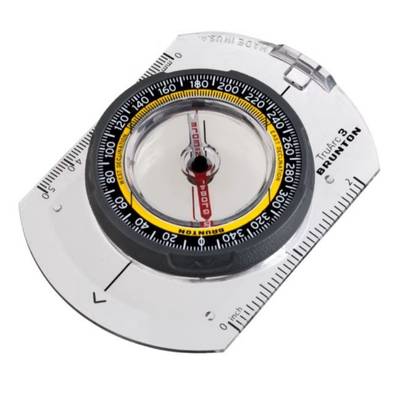
Brunton TruArc 3
The Brunton TruArc is a simple, cheap, and lightweight baseplate compass for those looking for something simple that won't take up a lot of space. Despite how small and cheap it is, the TruArc has a global needle.
The TruArc also offers rulers in both centimeters and inches and is durable and waterproof even though it costs so little. Another advantage is that you can adjust the declination on the Brunton TruArc without any tools. Usually, you need a key to turn the compass and adjust the declination; you can quickly do that by hand with the TruArc.
While the TruArc is more than accurate enough for most hikers, it is not good enough if you want top-end accuracy. Compasses that offer exceptional accuracy tend to be more expensive, and the TruArc is sold for a low price. It is best for people who want a small, simple, pocket-sized device.
3) Silva Ranger 515
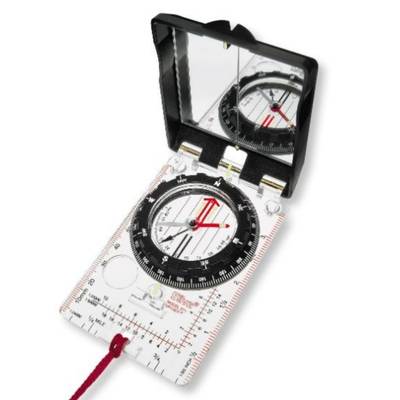
Silva Ranger 515
The Silva Ranger 515 is a durable analog compass with a longer list of interesting features than most of the competition. The Ranger 515 is also accurate, so it has quite a lot going for it.
The glow in the dark paint on the Ranger 515 is noticeably brighter than for most other compasses. It is a good choice if you find other glow in the dark compasses too dim.
The Ranger 515 offers a magnifying glass for map reading, a mirror, rulers, and adjustable declination. It has all of the features that people commonly want in an analog compass.
A less common feature of the Ranger 515 is its clinometer. A clinometer is a measuring tool you can use to determine how steep a slope is. A clinometer is not just a gimmick - in a dangerous environment; it can save your life by keeping you away from an avalanche.
If you are in an environment where you have to worry about avalanches, you can use the clinometer to tell whether a slope is steep enough to be avalanche prone. The Silva Ranger 515 is a great product with no disadvantages other than its relatively high price. One could argue that this is the best compass for hiking you can buy today.
4) Celestron 48003 TrekGuide
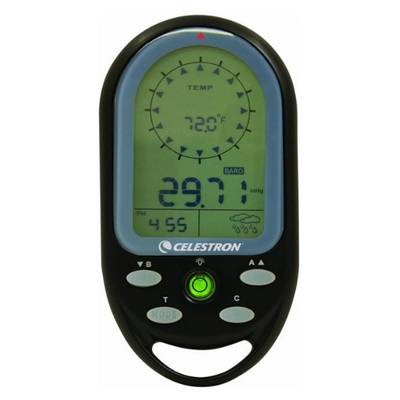
Celestron 48003 TrekGuide
If you don't mind bringing a compass that requires batteries, digital compasses often have features that analog compasses never do. The Celestron has an altimeter, so you can tell how far you are above sea level wherever you are.
Like other digital compasses, the Celestron has battery-powered lighting, so you can easily read it during the night. The Celestron also works as a thermometer and as an alarm clock. As well as displaying date and time, the Celestron shows you weather reports.
While all digital compasses have the disadvantage of requiring batteries, the Celestron uses powerful lithium-ion batteries that last a long time. One disadvantage of the Celestron is that the altimeter is not very accurate. If you return to the same area on another day, you will get a different reading.
If you want an altimeter, you can find a digital compass that gives more accurate readings. Unlike the altimeter, the compass is accurate. There is also a barometer if you are interested in using one.
5) Casio Men's SGW100B-3V Digital Compass Watch
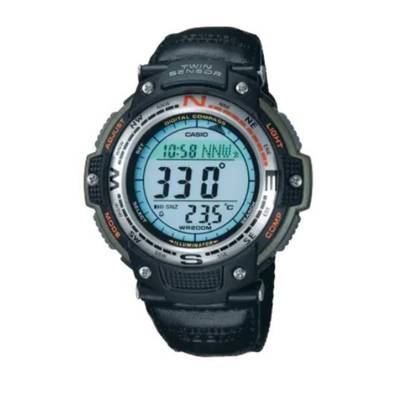
Casio Men's SGW100B-3V Digital Compass Watch
You might think that a digital compass watch would be a gimmick product, but the Casio Compass Watch is more reliable and accurate than many other digital compasses.
Cheap digital compasses can be flimsy; the Casio is more durable, and the screen is resistant to scratching. Most importantly, this compass is waterproof. Cheap digital compasses can quickly fail if they get wet; the Casio can withstand the elements while being affordable.
The Casio does not offer as many features as many other digital compasses do. While it does work as a watch, a stopwatch, an alarm clock, a world clock, and a thermometer, it does not have anything like an altimeter or weather reports.
If a compass/watch that you wear on your wrist is what you want, the Casio is worth it. It is something you can count on and not a cheap novelty product. What is most impressive is how waterproof the Casio is - you can even take it diving without problems as long as you don't go too deep underwater.
6) Cammenga Lensatic Compass
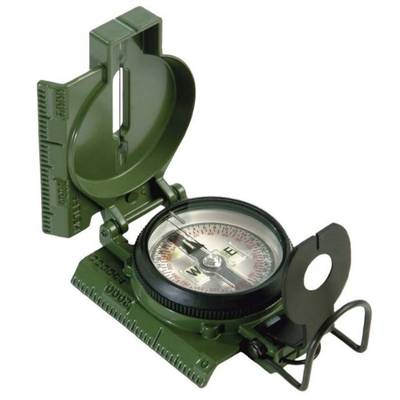
Cammenga Lensatic Compass
Since a compass is a survival tool, the last thing you want is a compass that can break. The Cammenga Lensatic is a particularly durable compass that can stand up to cold and shock.
The Cammenga's durability is so impressive that the U.S. Army has been using it for years. Since the U.S. army trusts it, it is no surprise that the compass is also accurate. While the Cammenga is somewhat more expensive than cheaper compasses, it will last a long time.
The Cammenga will light up at night without batteries for 12 years after you buy it. It does not use a typical glow in the dark technology; instead, it uses tritium microlights. Tritium is radioactive and can be used to power small lights.
The container that the needle is housed in is full of air rather than liquid, so no bubbles can form in the cold or at high altitudes. It does not offer a clinometer or other distinctive features, but it is still a great choice. It is built to last and accurate as a compass should be.
7) Eyeskey Tactical Survival Compass
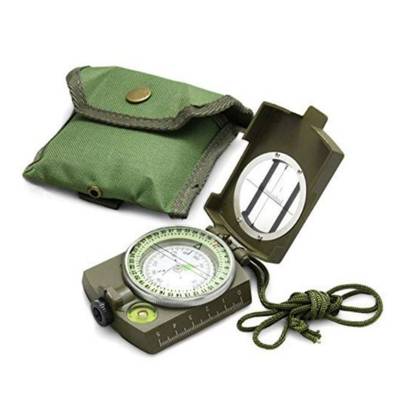
Eyeskey Tactical Survival Compass
One of the best things about the Eyeskey EK-01 is how fast and stable the needle is. You do not have to hold the compass flat for long to get it to work; it moves into place quickly. Once the needle is in place, it stops rather than wobbles - if you hate wobbly needles, you won't have this problem with the Eyeskey.
While the Eyeskey does use a liquid, it is not likely to freeze. The liquid is very freeze resistant unless the temperature goes below -30C. You can take the Eyeskey out in any weather you would hike in, even if you hike in the winter.
The Eyeskey also has a durable metal casing, making it unusually resistant to shock. It can be mounted on a tripod and has a conversion chart on the back for those who know enough about land navigation.
Recent Articles



